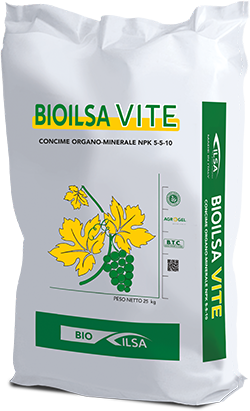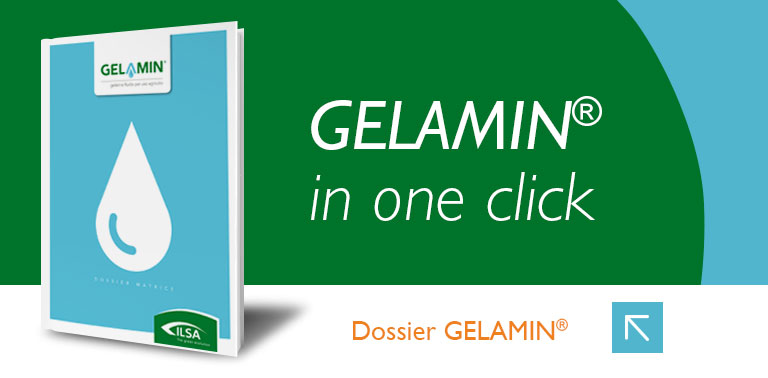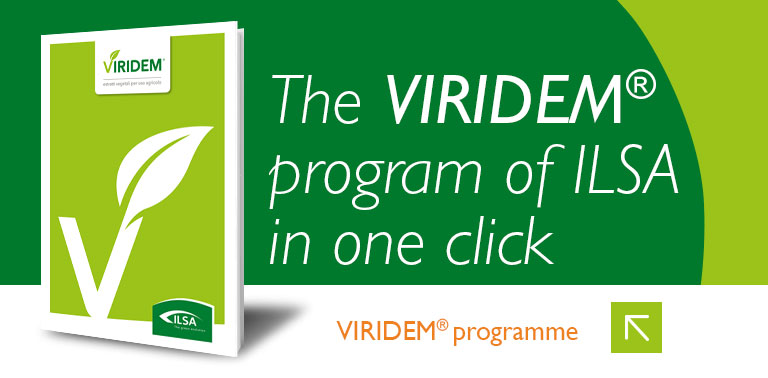NPK 5.5.10
CONTAINS AGROGEL®
What is it?
BIOILSA VITE is a pellet organo-mineral fertilizer that is characterized by a balanced content of organic nitrogen, phosphorus, potassium, calcium, magnesium and sulfur bound to the protein matrix Agrogel®, which prolongs its availability over time and allows efficient release throughout the crop cycle thus increasing yield and final quality. The high presence of organic carbon allows BIOILSA VITE to increase the microbiological fertility of the soil and also make other elements brought in by green manure or by burying crop residues more available to plants.
How to use?
The specific ratio of nutrients makes BIOILSA VITE suitable for vines and, in general, for all tree and horticultural crops, even in mixture with other nitrogen sources. It is ideal for applications in post-harvest or at vegetative restart of wine and table grapevines, fruit trees, and in pre-sowing/transplanting of open-field and greenhouse horticultural crops. The nature of the raw materials and the quality of the production process allow BIOILSA VITE to be used in organic farming.
Which benefits does it bring?
- Complete and prolonged nutrition;
- reduction of soil interventions;
- increased yield and final quality;
- very high economic efficiency.
COMPOSITION
-
Total Nitrogen (N) 5 %
- Of which: Organic Nitrogen (N) 5 %
- Total Phosphorus Pentoxide (P2O5) 5 %
- Water soluble Potassium oxide (K2O) 10 %
- Total Calcium Oxide (CaO) 15 %
- Magnesium Oxide (MgO) 4 %
- Water soluble Sulfur trioxide (SO3) 9 %
- Organic Carbon (C) 20 %
Doses and methods of use of the fertilizer
-
Citrus
-
All600-1000 kg/haGrowth recovery or post-harvest
Covering or underground
-
-
Fruit
-
Blackberry600-1000 kg/haGrowth recovery or post-harvest
Covering or underground
-
Blackcurrant600-1000 kg/haGrowth recovery or post-harvest
Covering or underground
-
Blueberry600-1000 kg/haGrowth recovery or post-harvest
Covering or underground
-
Hazelnut600-1000 kg/haGrowth recovery or post-harvest
Covering or underground
-
Kiwi600-1000 kg/haGrowth recovery or post-harvest
Covering or underground
-
Pistachio600-1000 kg/haGrowth recovery or post-harvest
Covering or underground
-
Raspberry600-1000 kg/haGrowth recovery or post-harvest
Covering or underground
-
Redcurrant600-1000 kg/haGrowth recovery or post-harvest
Covering or underground
-
Walnut600-1000 kg/haGrowth recovery or post-harvest
Covering or underground
-
-
GrapeVine
-
All600-900 kg/haGrowth recovery or post-harvest
Covering or underground
-
-
Olive Tree
-
All600-1000 kg/haGrowth recovery or post-harvest
Covering or underground
-
-
Pome fruits
-
All600-1000 kg/haGrowth recovery or post-harvest
Covering or underground
-
-
Stone fruits
-
All600-1000 kg/haGrowth recovery or post-harvest
Covering or underground
-
-
Tropical Crops
-
All500-800 kg/haGrowth recovery or post-harvest
Covering or underground
-
-
Vegetables
-
Asparagus600-800 kg/haPre-sowing or pre-transplant
Covering or underground
-
Beetroot600-800 kg/haPre-sowing or pre-transplant
Covering or underground
-
Brussels sprouts600-800 kg/haPre-sowing or pre-transplant
Covering or underground
-
Carrot600-800 kg/haPre-sowing or pre-transplant
Covering or underground
-
Cauliflower600-800 kg/haPre-sowing or pre-transplant
Covering or underground
-
Celery600-800 kg/haPre-sowing or pre-transplant
Covering or underground
-
Courgette600-900 kg/haPre-sowing or pre-transplant
Covering or underground
-
Cucumber / Gherkin600-800 kg/haPre-sowing or pre-transplant
Covering or underground
-
Eggplant600-800 kg/haPre-sowing or pre-transplant
Covering or underground
-
Fennel600-800 kg/haPre-sowing or pre-transplant
Covering or underground
-
Garlic / Scallion600-800 kg/haPre-sowing or pre-transplant
Covering or underground
-
Leek600-800 kg/haPre-sowing or pre-transplant
Covering or underground
-
Melon600-900 kg/haPre-sowing or pre-transplant
Covering or underground
-
Onion600-800 kg/haPre-sowing or pre-transplant
Covering or underground
-
Pepper600-900 kg/haPre-sowing or pre-transplant
Covering or underground
-
Radish600-800 kg/haPre-sowing or pre-transplant
Covering or underground
-
Savoy Cabbage600-800 kg/haPre-sowing or pre-transplant
Covering or underground
-
Spring Cabbage600-800 kg/haPre-sowing or pre-transplant
Covering or underground
-
Strawberry600-900 kg/haPre-sowing or pre-transplant
Covering or underground
-
Tomato600-900 kg/haPre-sowing or pre-transplant
Covering or underground
-
Turnip600-800 kg/haPre-sowing or pre-transplant
Covering or underground
-
Turnip Tops600-800 kg/haPre-sowing or pre-transplant
Covering or underground
-
Watermelon600-800 kg/haPre-sowing or pre-transplant
Covering or underground
-
Dosages are purely indicative and may vary depending on pedoclimatic conditions and average yields expected.








.png)
















